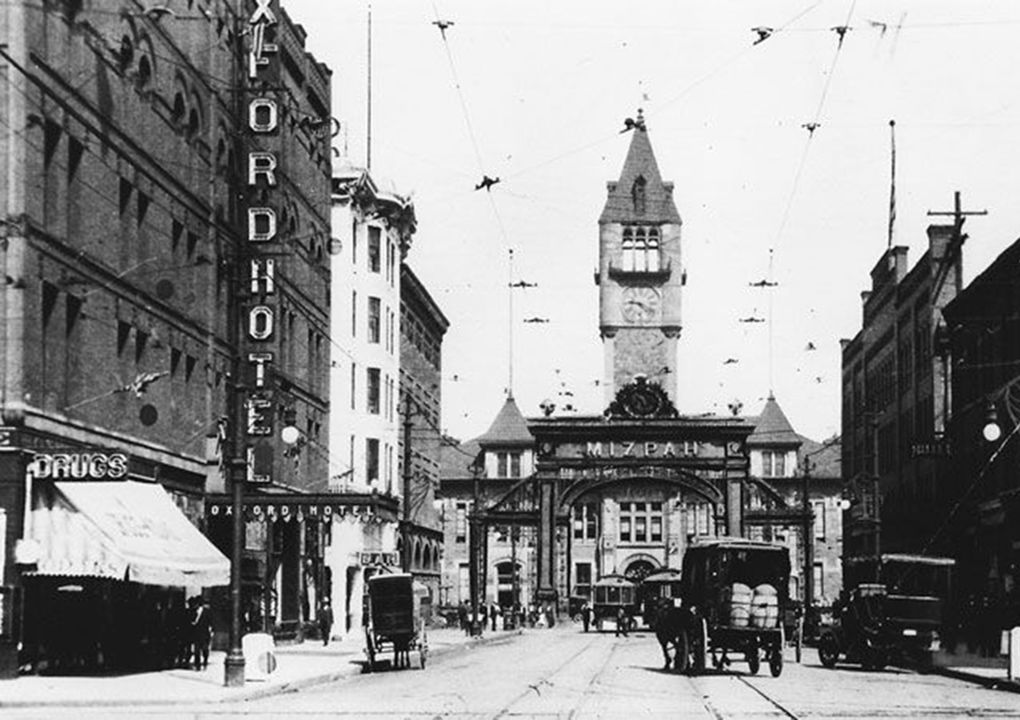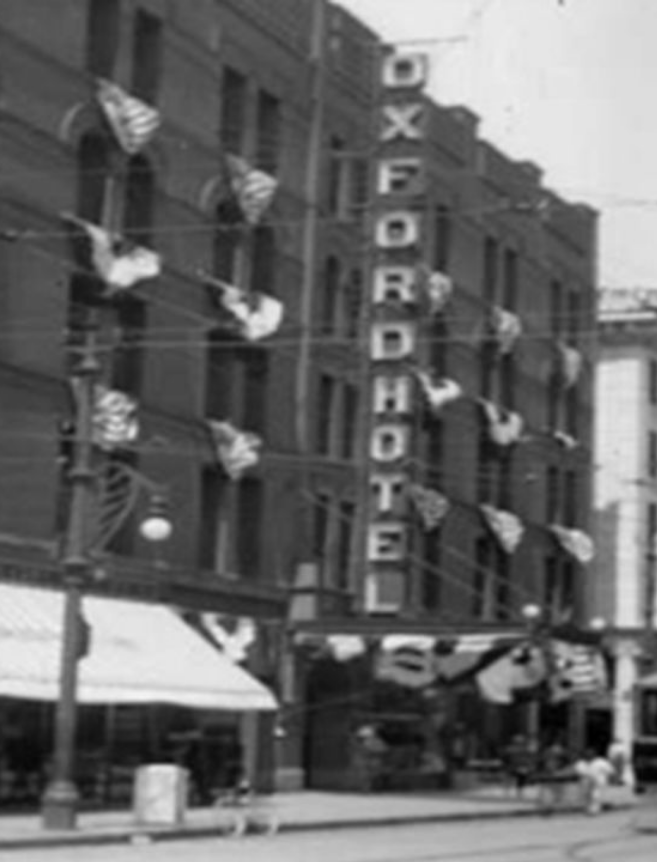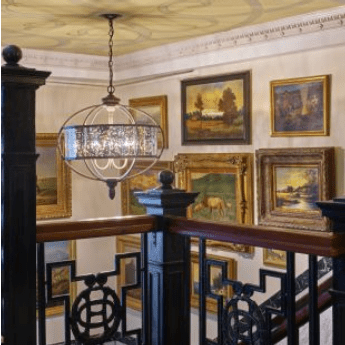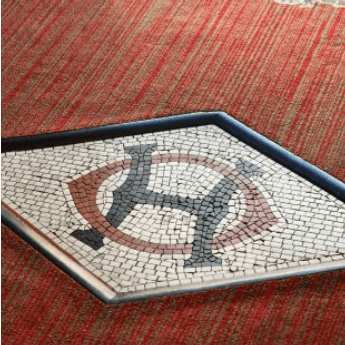Our History
Explore the Historic Beginnings of a Denver Icon
Since our founding in 1891, The Oxford Hotel has seen Denver through high and low moments, persevering through it all. Beginning with the elegance of Gilded Age, our historic Denver hotel has always adapted to the changing world. From the Art Deco stylings of the 1930s and the tourism boom of the 1950s, to major renovations in the 1980’s and early aughts, The Oxford Hotel is a true reflection of Denver throughout history.
Follow the timeline below to learn the story behind one of Denver’s most iconic landmarks.
Today, The Oxford Hotel is owned by Sage Hospitality with Dana Crawford.
Hear It From Dana Crawford Herself
Follow the timeline below to learn the story behind one of Denver’s most iconic landmarks.

1870
The year 1870 saw the arrival of major railroads to the small mining supply town of Denver. With this change came an influx of people that transformed a small town into a regional metropolis of the High Plains and the Rocky Mountains.

1890
After the major population boom that began in the 1870s, Denver quickly became the third largest city in West and 25th largest in the United States. By 1890, the population had reached 106,713 and Denver became the hub of a steel spider web – a network of more than 100 different Colorado railroads that tapped a rich mountain and plain hinterland.
1891
In the midst of a period of great transition in Denver, The Oxford Hotel was completed. Conceived by Colorado’s leading architect, Frank E. Edbrooke, The Oxford stood five stories high and preceded Edbrooke’s completion of The Brown Palace by one year. The Oxford came to fruition after local building and brewing tycoons – Adolph Zang, Philip Feldhauser, and William Mygatt – saw the need to create a first-class hotel near Union Station.


1893
The Panic of 1893 – one of the worst nationwide economic depressions in history – hit the U.S., ushering in an age of uncertainty. William Mygatt, a partner of The Oxford, sold his shares to Job A. Cooper, a former governor of Colorado. Like Zang and Feldhauser, Cooper retained a lifelong interest in The Oxford.
With the exception of Mygatt’s departure, The Oxford Hotel emerged from the Panic prosperous despite the nationwide bank, railroad, and mine closures.
1902
The turn of the century brought with it a thriving period of success for The Oxford Hotel. Hotel manager, Calvin Morse, reported that the hotel hosted 35,000 guests a year and frequently “had to turn many people away.” This time of prosperity lead the owners to construct a $75,000, two-story addition behind the property on Wazee Street. This 1902 addition matched the terracotta and pink sandstone trim of the original façade.

1906
The Oxford Hotel management team shifts, with Charles B. Hamilton and James L. Brooks named as the new managers. Hamilton and Brooks embark on a $20,000 remodel of The Oxford, adding in a mezzanine with a monogrammed, “OH”, on the iron banister. They also added marble wainscoting, a café, and an exterior entrance to the basement barbershop.
1912
Hamilton and Brooks continue to improve and expand The Oxford, adding a five-story annex into the mix. Designed by Denver architect, Montana Fallis, the new annex was constructed on 17th Street and carefully matched the design of 1891. In addition to the annex, Hamilton and Brooks had their initials, “HB,” monogrammed into the hotel’s white porcelain façade.
The completion of the annex brought The Oxford Hotel complex within a half block of Union Station, an advantage not lost on baggage-toting travelers or The Oxford Hotel’s marketing team. The ads of 1912 called to visitors “Just through the Welcome Arch. The Real Hub of Denver.”


1930s
Over the next 20 years, the U.S. underwent many changes in style and taste. The Oxford entered the 1930s ready for yet another remodel. Denver architect Charles Jaka took on the project, transforming The Oxford into an Art Deco showcase, reflective of the time. In the new Cruise Room cocktail lounge – featuring hand-carved panels by artist Alley Henson – Denverites enjoyed the repeal of the Prohibition Amendment.
During World War II, the influx of troops arriving at Union Station filled The Oxford to maximum capacity, from its attic to the broom closets. Mothers of Denver servicemen would set up shop to serve hot coffee, doughnuts, and turkey sandwiches to the troops 24 hours a day.
1950s
After the end of World War II, Denver began its second major boom- emerging as a national center for tourism, federal offices, and energy firms. The town began to rebuild its downtown, demolishing many of its landmarks and virtually all of its nineteenth-century hotels. The Oxford survived this period of transition as a bastion of respectability in a declining lower downtown.

1960s
The 1960’s and ‘70’s saw The Oxford become a center for jazz, folk music, and melodrama. Hundreds would pack into the hotel at night to see The Oxford Players’ rendition of “Ten Nights in a Barroom” as well as the Queen City Jazz Band.
As train travel began to rapidly decline, Union Station was left obsolete, standing as a mausoleum of years past. This void lead to a skid row forming in lower downtown. However, the success of the reimagined Larimer Square opened the city’s eyes to the possibilities of the grand architecture of Colorado’s silver age.


1979
As consumer needs began to shift, The Oxford was in need of an update. In 1979, Charles Callaway purchased The Oxford and closed its doors for restoration. Dana Crawford – the mastermind behind the restoration of Larimer Square – joined Callaway the following year.
William Muchow & Associates, a Denver architectural firm, was selected to engineer the restoration. Bill Muchow took a special interest in the project because his father worked as a tile mason for the annex construction of 1912.
Completely updated and modernized for the twentieth century, The Oxford transformed while still retaining its historic charm. Carpets were matched to the original design and chandeliers were stripped of paint to reveal sterling silver details. The former site of the restaurant, barber shop, or coffee shop was transformed into the Sage Room. The famous Cruise Room was returned to its Art Deco zenith.
1983
Three years of restoration and $12 million later, The Oxford reopens its doors to the public as Denver’s Grand Boutique Hotel on June 19, 1983. New features included the conversion of the annex into professional offices. Now a registered landmark on the National Register of Historic Places, this Denver staple had finally returned.

2009
The move into 21st century brought yet another round of renovations. As part of a seven-year room-by-room renovation, The Oxford team hired an iron artist to create a replica of the original doorway arch. This throwback to The Oxford’s early beginnings was one of many historical details included in the continued modernization of the property.


Today, The Oxford Hotel is owned by Sage Hospitality Management with Dana Crawford. Sage Hospitality oversees the continuous restoration of the property’s unique historical details while upgrading its features and amenities to meet the needs of modern travelers. A step into The Oxford’s extravagant lobby is a step back in time, made complete with all the comforts of the 21st century. It stands today as one of Denver’s most luxurious landmarks.
The Oxford Art Collection
A work of art itself, The Oxford Hotel is home not only to architectural marvels of the Gilded Age, but also to an exquisite collection of art. Spanning generations, our collection features works evocative of our storied past. Western landscapes remind of us our humble beginnings, while Art Deco pieces bring us back to the extravagance of the Prohibition era. View our art collection in the gallery below for an authentic look at our historic Denver hotel.










